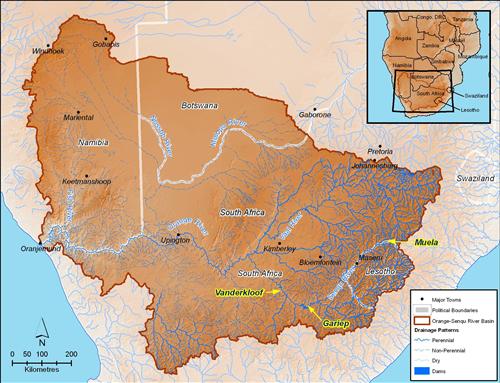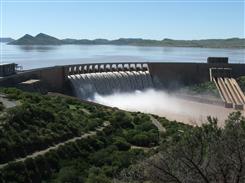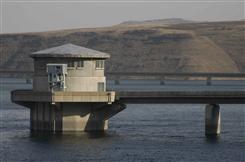Hydropower stations in the Orange-Senqu River basin are found in the Senqu, the Vaal and the Upper and Lower Orange sub-basins, supplying power to South Africa and Lesotho.
No hydroelectric power generation occurs within the area of Namibia or Botswana that falls inside the Orange-Senqu River basin.
Hydroelectric Power Generation in Lesotho
Muela Hydropower Station (MHS) in Lesotho, commissioned in late 1998, takes advantage of the yield from the Lesotho Highlands Water Project (LHWP) Phase 1 Katse Dam to generate electricity. Previously, Lesotho depended entirely on electricity imported from South Africa’s state-owned Eskom energy utility. Muela Hydropower Station has a combined generation capacity of 72 MW (often exceeded at a full capacity of 80 MW) with each of its three turbines generating 24 MW. This beneficial bi-product of Lesotho Highlands Water Project generally meets Lesotho's electricity requirements (LHWP 2009); when national demand exceeds the 72 MW operating limit, electricity often needs to be purchased from Eskom to compensate. The currently volatile energy supply situation in South Africa has on occasion affected Eskom’s ability to honour export agreements, and there are times when Lesotho is unable to import the necessary electricity to top-up its own supply.
The Muela Hydropower Station is often at full capacity (just over 80 MW) to provide enough electricity to its consumers; a situation that cannot be maintained during maintenance or interruptions in operation. Of greatest significance is the fact that the full capacity rate cannot exceed the annual agreed volume of 780 Mm³ of water to be delivered by South Africa (LHWP 2009).
In a 2009 interview, the Minister of Natural Resources, the Honourable Monyane Moleleki indicated that there are plans to expand the Muela Hydropower Station to meet increasing demands.

Major hydroelectric power generation dams in the basin.
Source:Hatfield 2009
( click to enlarge )
Hydroelectric Power Generation in South Africa
The Gariep and Vanderkloof stations are the only conventional hydro-electric power stations in South Africa. Eskom provides South Africa with 95% of its electricity and of this only 5% comes from hydroelectric generation. The remainder is generated by coal-fired power plants (Eskom 2007). The Gariep and Vanderkloof Power Stations are situated in the Upper Orange Water Management Area in the Eastern and Northern Cape Provinces and are integrated into the Gariep and Vanderkloof Dams, on the Orange River.
Both Vanderkloof and Gariep dams supply electricity during peak and emergency demand periods—known as peaking stations. The power generated feeds into the Eskom National Grid in South Africa to cover emergency shortages. The power stations produce base-load energy during times of flood risk to prevent the dams from spilling water and to take advantage of an opportunity for low cost energy production.
Table1: Technical information pertaining to the power stations.
|
|
Gariep
|
Vanderkloof
|
|
Full load station capacity
|
360 MW
|
240 MW
|
|
Maximum flow rate
|
800 m3/s
|
400 m3/s
|
 Gariep Dam, South Africa. Source:Pyke 2006 ( click to enlarge ) |
 The Katse-Vaal intake tower, located in the reservoir of Katse Dam, transfers water from Katse Dam, through Muela Power Station to the Vaal River. Source:Vogel 2009 ( click to enlarge ) |
Water is released twice a day from these large hydro power stations, causing a significant change in downstream water-levels and flow compared to the un-dammed flow. These modifications to environmental flows have resulted in stabilisation of the temperature regime in the water, detectable up to an estimated 180 km downstream. There has also been a loss of small flood events that stimulate fish breeding, and reduced turbidity as the dams capture sediment (WCD 2000).
Vaal River Power Generation
The Upper Vaal River Water Management Area supports electricity generation in the Gauteng area. However, these are not hydro-electric power stations; the main form of electricity generation in the area is coal power plants and water is mainly used for cooling. Grootdrai Dam supplies Turton, Dvha, Matla, Kendal and Kriel Power Stations with water.
